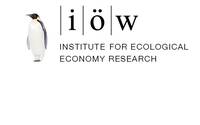Work Package 4: Input-Output Modeling
Target: Analyzing adaptation options for regional economies
Task: The main objective of this work package was to quantify effects on income and employment, triggered by climate change adaptation, rectification of damage caused by extreme climatic events, and by climate related change in tourism. Since climate change will differ regionally, economic effects were investigated in climatically and topographically different regions in Germany. It was also necessary to take into account the differences between economic sectors in case of climate change vulnerability to estimate sectoral income and employment effects. To do so, the IÖW developed a regional dynamic input-output model. With its help, region- and sector-specific direct, indirect and income induced effects triggered by changes in regional demand for capital and consumer goods were estimated.

Causes for such changes in demand could be, for instance, increased requirements for coastal preservation, changes in tourism, and increase in extreme weather damage. Challenges associated with the input-output analysis are on the one hand construction of regional input-output tables and on the other hand development of a dynamic input-output model. In Germany official input-output tables are only available for the entire national economy but not for individual areas. Therefore, it is necessary to compile regional input-output tables for both regions of interest. Where available, sector-specific data on employment, production, gross value added tax, and trade were derived from official statistics complemented by expert surveys especially regarding interregional trade structures. Changes in household consumption, public consumption, investments, and exports, which are due to climate change, were particularly important inputs for this analysis. To address these changes, WP 3 provided these inputs on a national level. These results were applied to both regions of interest by taking into account the specific regional characteristics.
Furthermore, input structures of economic sectors and the respective input coefficients were adapted to the changing production conditions. Examples for climate related changes in production are an increase in agricultural water use and an accelerated deduction of sectoral capital stocks due to more frequent and severe damages. Part of the dynamic component of the input-output model is incorporated by taking into account the development of sectoral capital stocks and the necessary capacity adjustments caused by changes in demand. Additionally, dynamics on the national level from Work Package 3 served as important input variables for the regionalized model.




